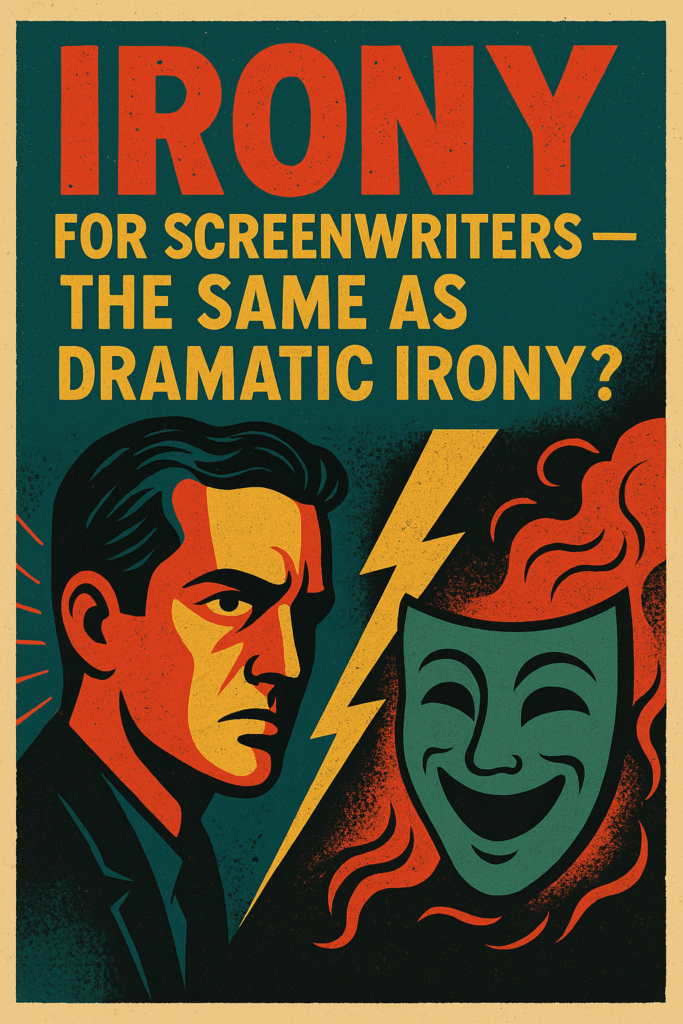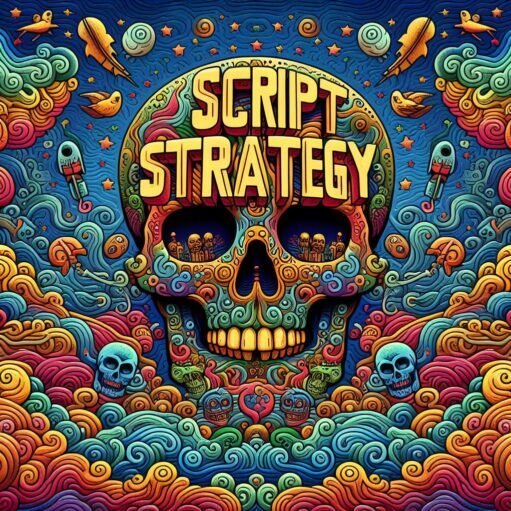Irony for Screenwriters — The Same as Dramatic Irony?
A good heuristic is that the literal meaning of a statement is the exact opposite of the actual meaning of that statement.
Irony is of course a bit more complicated than that, at least in screenplay terms.
In particular, Irony doesn’t require exact opposites. Nevertheless, if this is getting heady, just run with the Reality Bites definition. It’s better than a kick in the teeth. Or Alanis Morissette’s definition, for that matter.
Is This Dramatic Irony?
The key question for us is how we can develop a concept that isn’t all smoke and mirrors: something that actually interests people and gives them some sort of inkling as to where the story will progress
To do this, we need some sort of toolkit or set of best practices. I think that we’ve elsewhere sufficiently mocked the pitfalls of the paint-by-numbers approach.
What we need to discuss is what really works. One of the key points to this is Irony.
Definition of Dramatic Irony
Theoretically speaking, Dramatic Irony refers to the audience knowing something about a situation that the characters don’t know.
Like: they’re in a raft and don’t see the waterfall ahead, but we do!
It’s actually a bit more specific in screenplay terms. Remember the core principles of Irony, Conflict, and Change.
What we want is actually sort of a combination of what marketers might call a Hook: something that is weird and incongruous and begs questions, then figuring out an extreme and upsetting outcome that this situation begs.
For example, in The Apartment, Baxter lets his bosses conduct their clandestine flings in his apartment (Hook), but shit gets real once Baxter’s big boss starts (ahem) entertaining the lady Baxter likes in Baxter’s own apartment (this is the ironic part).
Now we have to figure out how this plays out–it’s sure to raise some Conflict, of course.
So perhaps it is true Dramatic Irony for as long as the audience is aware that the problem exists yet Baxter, for example, doesn’t. So perhaps there’s something more here–it’s not just about the character not knowing, but about being able to make a non-obvious connection.
The real gift of Irony in a screenplay, however, is that it queues up the worst thing that could possible happen in this situation. This will, ideally, make perfect sense to the audience yet not be immediately obivous.
That’s a tough balance to strike and requires a lot of time and effort. These are the stories that we want to see played out. Explored. Occasionally even solved.
Let’s dig in to how to do it.

A Perfect, Unseen Connection
That is, you open a situation where you’ve got two sides to an argument and it’s initially unclear how those two things connect. You work them closer and closer to each other, until people are able to bridge the gap in their own minds.
It’s actually the act of bridging the gap that makes jokes funny. Sit with that idea for a moment. It will make sense soon enough.
You see, once we get it—and that’s the point of the term “get it”–that means that we have bridged the gap. In essence, it forces us to engage.
That’s why people like comedy; it forces us to engage intellectually in a way that something that’s spoon fed to us would not. That may be changing with AI spoon-feeding us everything, which potentially also explains why the biggest comics today are basically just not funny.
Look at it from the other side: a joke’s not funny if the point of the joke is obvious, because there’s no gap there.
What we need to do in creating a film concept is to create an ironic gap. We need a juxtaposition of ideas that hints toward thinking about an idea in a particular way, yet doesn’t smack us in the face with the idea.
Fundamentally, we are looking for a subversion of expectation that is just hidden enough that the audience must engage to “get it.” We present the Gap and allow the audience to bridge it themselves.
Subversion of Expectation
Big words! What I mean by this, effectively, is that you—the audience–receive something that doesn’t match what you expected to receive. This is where the humor lies.
This is the part of the joke that doesn’t quite line up. It doesn’t make perfect sense in terms of the setup. That’s what’s intriguing about it. If it’s the obvious answer—if it makes perfect sense, or it’s what we expected to hear all along—then it’s not funny.
For example, if we say “Why did the chicken cross the road? To get to the other side,” it seems boring—but that’s only because we know the joke. There’s still a subversion of expectation insofar as that we expect there to be some sort of (more) rational reason that we would choose to cross the road.
That is, we’re looking for a “why did he do it?” There could be any number of reasons: were there excellent grubs crawling around in the grass on the other side? Was there a rooster so gorgeous that she simply had to talk to him?
The reason that it subverts expectation is because you say “to get to the other side.” Here we take an obvious literal meaning, but we expect a deep and philosophical justification for the road-crossing “why,” or at least a practical one.
In short, the “why” indicates that crossing the road should be a means to an end, not the end itself. Here’s our record-scratch moment.
“She crossed the road because she’s a two-pack a day smoker and her butts were on the other side of the road.” There’s got to be some reason—we really want to hear something—and it’s not there.
Semantically, the word “why” by its nature asks us for a justification. When we don’t get that, it creates that ironic short-circuit in the brain and demands some sort of laugh.
And there’s the humor.
If the audience is unable to bridge the gap, then there’s something wrong with the gap.
The goal is to create a gap that is just so far. It must allow the people to do the work for themselves, yet not be so abstruse that they simply blink and stare at you.
Do what comedians do: workshop it.
This is exactly why it’s a great idea to do market testing; in other words, that means pitch the living shit out of your concept to friends, family, and people in line at the grocery store.
Tell it to everyone you see. Monitor their reactions. Keep a spreadsheet and code them in cerulean if they like it, ochre if they are lukewarm, and puce if they outright fucking hate it.
If their reaction is good, great. You might just have something.
Exercises for Developing Irony in Your Screenplay
The Hook-and-Twist Test
- Write down three “straight” premises (e.g., a man gets promoted at work).
- For each, brainstorm an ironic twist that makes the premise unbearable or absurd (his wife is faithful, but his constant paranoia that she’s not drives her into another man’s arms)
- Circle the one where the twist naturally creates both conflict and a path toward the “worst possible outcome.” That’s your mini-screenplay seed.
Audience Knows, Character Doesn’t
- Draft a short scene (no more than 1 page) where the audience has crucial knowledge the character doesn’t.
- Example setup: We know the text message on the phone is a breakup note, but the character hasn’t opened it yet.
- The rule: build the scene so the tension comes entirely from the audience waiting for the character to bridge that gap.
- Bonus: Rewrite the same scene without dramatic irony, and notice how much flatter it feels.
Joke Workshop for Screenwriters
- Take a hacky “Why did the chicken cross the road?” structure (or another structure of your choice). Replace “chicken” with your protagonist.
- Write three punch line-style answers that subvert expectation while revealing something truthful about your character.
- Example: Why did Baxter lend out his apartment? Because it was easier than saying no—until it wasn’t.
- Highlight the answer that makes the audience work just enough to “get it.” That’s the gap.

